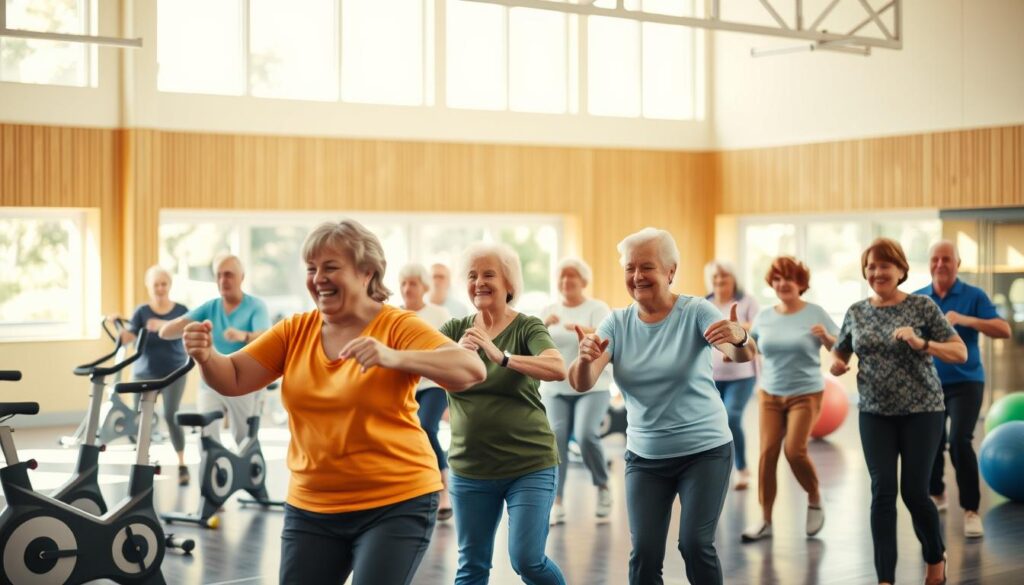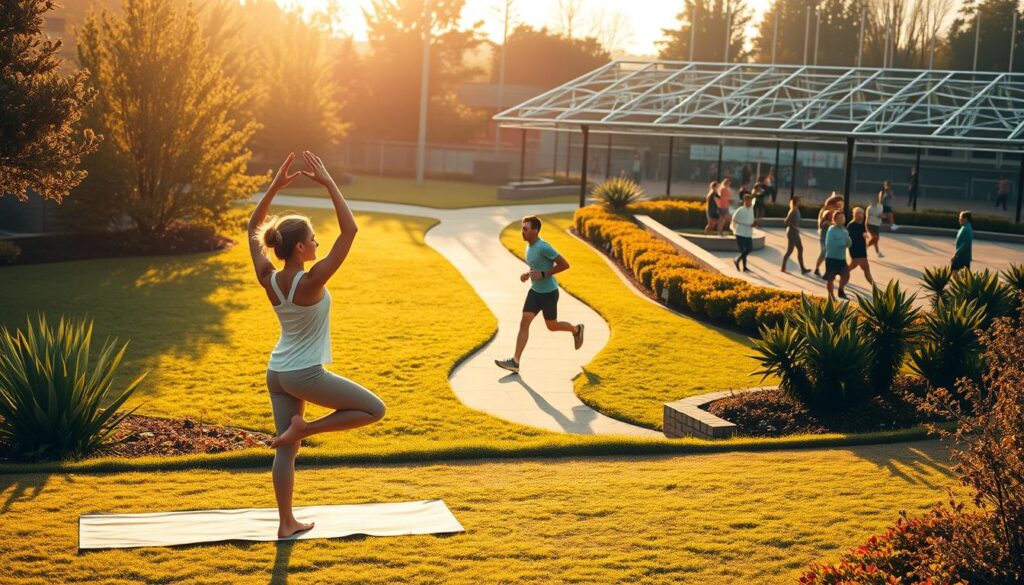Did you know sitting for over 7 hours a day is as bad as smoking? Let’s dive into why fitness is more than just going to the gym. Fitness is key for many reasons, not just how we look. Studies show it can lower heart disease risk by 30-40% and high blood pressure by 4-9 mmHg.
It also cuts type 2 diabetes risk by 30-50%. For those with arthritis, it eases pain and boosts mobility. Plus, it improves mental health, with 65% of exercisers sleeping better and 20-30% fewer depression symptoms.
But, 80% of adults don’t meet basic activity levels. Sedentary lifestyles are now as deadly as smoking, increasing risks for heart disease, diabetes, and cancer. The CDC says exercise helps manage osteoarthritis and aids in post-stroke recovery. Every 150 minutes of activity can add up to five years to your life.
Key Takeaways
- Regular exercise reduces heart disease risk by 30-40% and lowers early death risk by up to 30%.
- Physical activity improves sleep quality for 65% of participants and reduces arthritis pain for 60% of sufferers.
- Meeting weekly guidelines (150 minutes) may extend lifespan by up to five years.
- Exercise decreases depression symptoms by 20-30% and strengthens muscle mass to counter age-related loss.
- Even 150 minutes weekly cuts all-cause mortality by 19%, per research on 116,000 adults.
Why Is Fitness Important? Understanding the Fundamentals
Today, we often choose convenience over moving. But, knowing why fitness is key helps us see its value. The importance of exercise goes beyond looks. It boosts our health and helps us live longer. The American Heart Association says we should do 150 minutes of moderate activity each week. That’s just 30 minutes a day to keep our bodies and minds healthy.
Defining True Fitness in Modern Life
True fitness means being good at heart, muscles, and metabolism. Sitting too much can harm our hearts. So, it’s important to find a balance between work, rest, and exercise. This balance helps us stay healthy at any age.
The Five Components of Physical Fitness
| Component | Description | Health Impact |
|---|---|---|
| Cardiovascular Endurance | Ability of heart and lungs to supply oxygen during sustained activity. | Reduces heart disease risk; improves stamina. |
| Muscular Strength | Capacity of muscles to exert force during resistance. | Prevents osteoporosis; supports injury resilience. |
| Muscular Endurance | Ability to sustain repetitive muscle contractions. | Enhances daily tasks; aids metabolic function. |
| Flexibility | Range of motion in joints and muscles. | Prevents injury; improves posture and mobility. |
| Body Composition | Ratio of fat to lean tissue (muscle, bone, water). | Optimal ratios reduce chronic disease risks. |
How Regular Exercise Transforms Your Body
Regular exercise changes our bodies in many ways. Strength training builds muscle, boosting our metabolism and bone health. Cardio exercises make our hearts stronger, lowering our heart rate and blood pressure.
Exercise also boosts our mood and brain function. It releases endorphins, which are like natural happiness pills. These changes help us avoid chronic diseases and stay independent as we age.
The Profound Impact of Fitness on Physical Health
Scientific studies show that daily exercise is key to keeping us healthy. It makes our hearts stronger, improves blood flow, and lowers blood pressure. This helps prevent heart disease and stroke.
Being active also raises good cholesterol and lowers bad cholesterol. This fight against heart disease is a big win.

- Metabolic Health: Exercise makes our bodies better at using insulin, lowering the risk of type 2 diabetes.
- Bone and Muscle Strength: Lifting weights makes our bones and muscles stronger, helping us avoid fractures as we age.
- Immune Function: Regular exercise boosts our immune system, fighting off chronic inflammation and diseases like arthritis.
- Longevity: Staying active can even help us live longer by keeping our bodies healthy.
The U.S. Department of Health and Human Services suggests adults aim for 150–300 minutes of moderate exercise each week. They also recommend muscle-strengthening exercises twice a week. Even short walks or bike rides count towards these goals.
Consistency is key for the best results. Research shows that even 10-minute workouts throughout the day can improve heart health and boost energy. By making staying active a priority, we can lower disease risks and stay strong.
Fitness and Mental Wellbeing: An Unbreakable Connection
Science proves that exercise is good for our minds. It changes our brain chemistry and builds emotional strength. During exercise, our brain releases serotonin and dopamine, which help us feel better.
“Successful Olympians with high mental toughness demonstrate improved focus and resilience, directly tied to consistent physical training.”
Exercise as a Natural Antidepressant
Working out makes us feel happy by releasing endorphins. This feeling, known as a “runner’s high,” helps fight depression. Studies show it’s as good as some medicines for mild to moderate depression.
- Endorphins: Reduce pain perception and induce euphoria
- BDNF (Brain-Derived Neurotrophic Factor): Promotes neuron growth and repair
- Serotonin: Stabilizes mood and sleep cycles
Stress Reduction Through Physical Activity
Exercise lowers cortisol, the stress hormone. A 2020 study in Psychology of Sport and Exercise found even 30 minutes of walking daily reduces perceived stress by 25%. It helps calm our nervous system.
How Fitness Improves Cognitive Function
Exercise makes us smarter by improving memory and problem-solving. Here’s how:
| Benefit | Mechanism |
|---|---|
| Enhanced memory | BDNF stimulates hippocampal neurogenesis |
| Sharper focus | Increased oxygen flow to prefrontal cortex |
| Reduced cognitive decline | Exercise lowers Alzheimer’s risk by 35% (study, 2021) |
Building Confidence Through Fitness Achievements
Reaching fitness goals boosts our self-confidence. Achieving something like running a 5K or mastering yoga builds mental strength. Our physical and mental health are linked, each supporting the other.
Regular exercise is key to a healthy mind and body. A daily 20-minute walk can cut anxiety by 20%. Strength training also boosts confidence by showing real progress. Make exercise a priority to care for both your body and mind.
Social Benefits of Maintaining an Active Lifestyle
Being active does more than just keep you healthy. It helps you make friends and enjoy life more. Joining group workouts is a great way to meet people and share goals. Studies show that working out with others makes it easier to stick with it.
Building Community Through Group Fitness
Group activities like yoga or sports leagues help build community. When we work out together, we create strong bonds. Fitness classes make people happier and more consistent than working out alone.
How Exercise Enhances Interpersonal Relationships
Working out together strengthens family and romantic ties. Walking or cycling with a partner boosts communication and trust. Activities like rock climbing improve teamwork and empathy.
Families who go hiking together make memories and stay healthy. The CDC recommends less sitting time, and hiking is a great way to do that.
Fitness as a Platform for Networking
Running clubs or charity walks are great for meeting new people. Sites like Just Join In help you find local events. Even simple activities like dance classes can lead to new friendships or professional connections.
The Role of Fitness in Disease Prevention and Longevity
Regular exercise is key to preventing diseases and living longer. It helps lower risks for chronic conditions and boosts life expectancy. The CDC says adults who do 150 minutes of moderate activity weekly can cut heart disease, stroke, and type 2 diabetes risks by up to 30%. Workout benefits also include fighting cancer, with activity linked to fewer cases of eight major cancers, like breast and colon cancers.
“Physical activity is a modifiable factor with profound impacts on aging and chronic disease trajectories.”
Here are key tips for older adults:
- 150 minutes weekly of moderate aerobic activity (e.g., brisk walking)
- 2 days of muscle-strengthening exercises
| Condition | Risk Reduction | Recommended Activity |
|---|---|---|
| Heart disease | Up to 35% lower risk | Regular aerobic exercise |
| Type 2 diabetes | 50% reduced incidence | Muscle-strengthening exercises |
| Cognitive decline | 25-40% lower dementia risk | Consistent physical activity |
Exercise helps fight aging by improving insulin sensitivity and reducing inflammation. It also keeps muscle mass strong. Following activity guidelines can lower flu-related death risk by 50% and increase telomere length, a sign of aging. The World Health Organization says more activity can slow disease and add years to independent living. Making exercise a regular part of life can protect against many illnesses.
How Fitness Needs Evolve Throughout Life’s Stages
As we grow, our need for physical activity changes. This is due to changes in our body, lifestyle, and health goals. It’s important to stay active throughout our lives, matching our efforts to our current needs.
Childhood and Adolescent Fitness Foundations
Our early years set the stage for a healthy life. Kids aged 3–5 need lots of playtime. Those 6–17 should get 60 minutes of exercise every day. Teens also benefit from strength training, which helps them grow strong.
Studies show that regular exercise can lower teen anxiety by 30%. It also boosts their brain power.
- Children 3–5: Unstructured play to build motor skills
- 6–17 years: 60 daily minutes of aerobic, muscle, and bone-strengthening activities
- Adolescents: 2–3 weekly sessions of resistance training
Adult Fitness: Balancing Work, Family, and Health
Adults have many demands, but staying active is key. The CDC says adults should do 150 minutes of moderate exercise weekly. This can cut chronic disease risk by half.
Strength training twice a week helps prevent muscle loss. Adults should find a fitness routine that fits their busy lives. Working parents might do short, 10-minute workouts. Empty nesters might focus on longer, endurance activities.
| Age Group | Aerobic Goals | Strength Training |
|---|---|---|
| 20–30 | 150 mins/week moderate or 75 mins vigorous | 2+ days/week |
| 40–60 | Focus on cardio and flexibility | Incorporate low-impact resistance |
Senior Fitness: Maintaining Independence and Vitality

For seniors, fitness is about staying functional. The CDC recommends 150 minutes of low-impact aerobic activity weekly. This can lower fall risk by 30%.
Balance exercises and resistance training can help prevent osteoporosis. Even simple activities like gardening can help meet daily fitness goals.
“Exercise is the most effective non-pharmaceutical tool to delay age-related decline,” says the National Institute on Aging.
It’s important for older adults to focus on flexibility, balance, and strength. A regular exercise routine can delay chronic disease by 5–10 years. It also improves sleep. Always talk to a doctor before starting a new exercise plan, to address any health concerns.
Integrating Fitness Into Your Daily Routine: Practical Approaches
Starting a healthy lifestyle is all about small, consistent steps. Even short bursts of activity can cut chronic disease risk by 50%. The American Heart Association says any movement is better than none. Begin with easy steps to create lasting habits.
- Follow guidelines: 150 minutes of moderate activity (e.g., brisk walking) or 75 minutes of vigorous exercise (e.g., cycling) weekly.
- Split sessions: Two 15-minute walks daily meet weekly goals. High-Intensity Interval Training (HIIT) in 15-30 minute sessions offers efficient results.
- Gradual progress: Increase activity by 10% weekly to avoid injury. Track progress every 6 weeks to adjust routines.
Nutrition and Hydration Tips:
- Pair workouts with balanced meals: Prioritize protein, whole grains, and vegetables post-exercise for muscle repair.
- Stay hydrated: Drink water before, during, and after activity to maintain energy levels.
- Choose whole foods over supplements unless advised by a healthcare provider.
Rest and Recovery:
Make sure to include rest days to avoid overtraining. Active recovery—like yoga or swimming—helps muscles repair without strain. Aim for 7-9 hours of sleep each night to maximize benefits.
Small changes can make a big difference. Try taking stairs, walking pets, or joining group activities for motivation. Consistency builds lasting habits. Your body will gradually get stronger and more resilient.
Exploring Different Types of Fitness Activities for Maximum Benefit
Choosing the right fitness activities is key to meeting personal goals and lifestyle. Adults should aim for at least 150 minutes weekly of moderate-intensity activities. These include walking, cycling, or swimming, which boost heart health and reduce chronic disease risks. Adding muscle-strengthening exercises twice weekly—such as resistance band workouts or bodyweight squats—supports bone density and metabolic health.

- Endurance activities: Dancing, hiking, or pickleball improve cardiovascular function. Even yard work or housework counts toward weekly aerobic goals.
- Flexibility and balance: Yoga and tai chi enhance range of motion and prevent falls, critical for older adults. These practices also reduce stress through mindful movement.
- Mind-body practices: Tai chi’s slow motions combined with deep breathing can improve balance and mental focus. Yoga’s postures and breathwork reduce anxiety while building strength.
- Low-impact options: Swimming or gardening are gentle on joints, making them ideal for beginners or those with joint pain. Even daily walks count toward staying active.
Balance exercises like heel-to-toe walking or single-leg stands are vital for fall prevention. The American Heart Association recommends mixing activities to address endurance, strength, and flexibility. For instance, combining a 30-minute walk with yoga stretches builds holistic fitness. Listen to your body: stop if dizziness or pain occurs. Prioritize activities you enjoy—whether soccer, gardening, or dancing—to maintain consistency. Align choices with guidelines while respecting individual needs, ensuring staying active remains sustainable and fulfilling.
Overcoming Common Barriers to Maintaining a Fitness Regimen
Starting a regular fitness routine can be tough due to busy schedules and money issues. But, knowing how to deal with these obstacles can help you see the benefits of staying fit. It shows why fitness is key for keeping healthy over time. Research finds 80% of adults find it hard to meet activity goals, but there are proven ways to overcome this.
-
- Schedule workouts like appointments: 60% of scheduled exercisers stick to routines
- Opt for 10-minute sessions: Short bursts boost adherence while lowering blood pressure
- Combine tasks: Walking meetings or active commuting add’t reduce time barriers
/ul
Studies show 30% of individuals lack social support. Solutions include:
Group exercise increases adherence by 50% compared to solo workouts
-
-
- Join fitness communities or family activities to boost consistency
- Track progress visually to reinforce intrinsic motivation
- Pair exercise with social events, like walking groups
-
| Barrier | Solution | Impact |
|---|---|---|
| Lack of equipment | Bodyweight exercises (squats, push-ups) | 60% cost reduction |
| Weather dependence | Indoor options like online classes | 40% adherence in bad weather |
| Facility costs | Parks, home workouts | 25% increase in participation |
Beating barriers means finding practical solutions and changing your mindset. Using community resources and proven methods helps make physical activity a priority. Taking small steps today leads to big benefits of staying fit in the long run.
Setting Sustainable Fitness Goals and Tracking Progress
Setting realistic fitness goals means making them match your personal goals. The impact of fitness on well-being comes from taking small, doable steps. Using the SMART method—Specific, Measurable, Achievable, Relevant, Time-bound—can increase success by 42%, as shown by the Journal of Applied Psychology.

- Define Specific Objectives: Instead of “exercise more,” aim for “walk 30 minutes daily.”
- Track Metrics: Keep an eye on steps, sleep, and mood, along with how workouts make you feel.
- Adjust Dynamically: Life changes mean your goals should too. A study in the Journal of Sport & Exercise Psychology shows flexible plans help stick to goals longer.
Good ways to track progress include:
- Fitness apps for tracking activities
- Keeping a journal of sleep and mood
- Checking in weekly to tweak goals
| Goal Type | Example | Tracking Method |
|---|---|---|
| Process Goals | Weekly yoga sessions | Calendar checkmarks |
| Performance Goals | Running 5K in 30 days | Timer/Distance logs |
| Outcome Goals | Reducing body fat percentage | Monthly measurements |
Research shows 65% more people stick to their goals with support from friends. Working out with a buddy boosts workout benefits and keeps you accountable. Focusing on small wins, like better sleep, builds lasting habits. It’s the steady progress, not being perfect, that leads to lasting health benefits tied to the impact of fitness on well-being.
Conclusion: Embracing Fitness as a Lifelong Journey to Wellbeing
Exercise is more than just looking good. It’s key to feeling good too. It makes our bodies and minds stronger. It lowers the risk of serious diseases and boosts our mood and thinking skills.
Just 15 minutes of running or 60 minutes of walking each day can help fight depression. This shows how important exercise is for our mental health. It helps us deal with tough times better.
Having a mix of cardio, strength training, and flexibility in our workouts is best. It helps us feel better in all ways. Whether it’s a weekend run or a daily walk, staying active is good for our brains, sleep, and relationships.
Drinking enough water, eating right, and getting enough sleep are also important. Regular health checks help us see how far we’ve come. Every little bit helps, whether it’s a short walk or a full workout.
Seeing fitness as a lifelong choice is key. It’s not just for kids or adults, but for everyone at every age. Start small, with 30 minutes a day or a few times a week. Every step we take towards health makes us stronger, both in body and mind.





